A) A group of attributes
B) A set of permissible tuple values
C) A collection of related data items
D) A set of permissible attribute values
F) A) and B)
Correct Answer

verified
Correct Answer
verified
Multiple Choice
Consider the Registration relation shown in the exhibit. Which of the following SQL statements would return the Registration2 relation from the Registration relation? 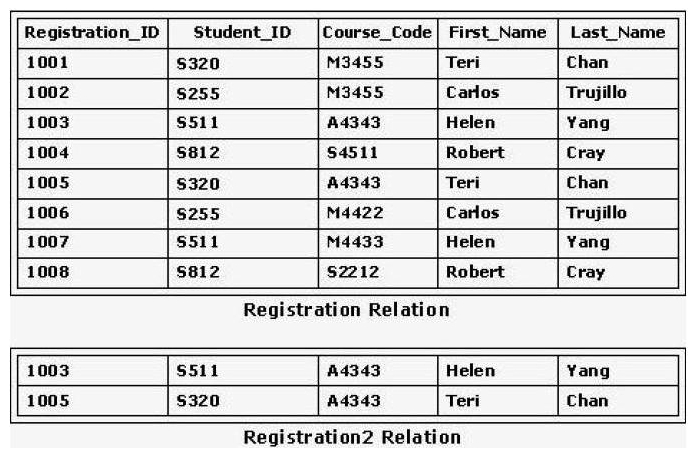
A) SELECT Course_Code FROM Registration;
B) SELECT * FROM Registration WHERE Registration_ID = 1003 AND Registration_ID = 1005;
C) SELECT * FROM Registration WHERE Course_Code = 'A4343';
D) SELECT Registration_ID, Student_ID, First_Name, Last_Name
F) A) and B)
Correct Answer

verified
Correct Answer
verified
Multiple Choice
What is the highest normal form of the relation(s) shown in the exhibit? 
A) Third normal form
B) Second normal form
C) No normal form
D) First normal form
F) A) and D)
Correct Answer

verified
Correct Answer
verified
Multiple Choice
Consider the following database information: domain s_id: integer domain grd: fixed length character string length 1 STUDENT_GRADE( Student_Number: s_id NOT NULL Grade: grd ) Primary Key Student_Number During which phase of the database design process would this information be developed?
A) Logical
B) Physical
C) Conceptual
D) Implementation
F) A) and D)
Correct Answer

verified
Correct Answer
verified
Multiple Choice
Which of the following definitions applies to all types of databases?
A) Data that is stored as tables
B) Software that manipulates data
C) Data that is stored in a structured manner
D) Data records that are stored sequentially in a file
F) A) and B)
Correct Answer

verified
Correct Answer
verified
Multiple Choice
Several SQL operations are performed by User 1 to access the Fee information for Bowling in the Act_Fee relation (shown in the exhibit) . The first access returns a fee of 50. An unrelated SQL operation by another user updates the Bowling fee to 60. The second access by User 1 returns a fee of 60. What problem has occurred? 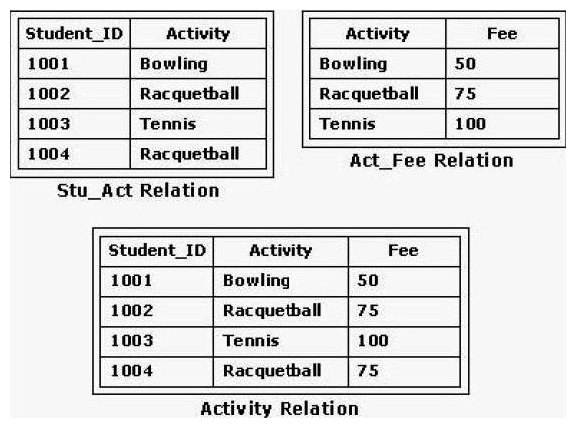
A) Rollback
B) Deadlock
C) Dirty read
D) No problem has occurred.
F) All of the above
Correct Answer

verified
Correct Answer
verified
Multiple Choice
Consider the relations shown in the exhibit. Which of the following SQL statements would enter data from the Customers relation into the Atlanta_Customers relation? 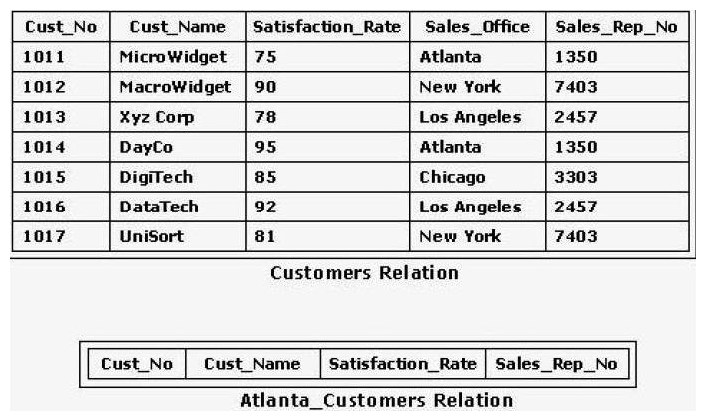
A) INSERT INTO Atlanta_Customers VALUES( SELECT * FROM Customer s WHERE Sales_Office = Atlanta
B) SELECT * FROM Customers WHERE Sales_Office = Atlanta
C) INSERT INTO Atlanta_Customers SELECT Cust_No, Cust_Name, Satisfaction_Rate, Sales_Rep_No FROM Customers
D) Cust_Name, Sales_Office, Sales_Rep_No FROM Customers
F) A) and D)
Correct Answer

verified
Correct Answer
verified
Multiple Choice
A theta-join can be viewed as:
A) The intersection of two relations
B) A Cartesian product of two relations
C) A restricted Cartesian product of two relations
D) The Cartesian product of two union-compatible relations
F) A) and C)
Correct Answer

verified
Correct Answer
verified
Multiple Choice
Which concurrency control method should be used only when conflicts between transactions rarely occur?
A) Locking
B) Time stamps
C) Optimistic
D) Serialization
F) A) and D)
Correct Answer

verified
Correct Answer
verified
Multiple Choice
Consider the entity-relationship (ER) diagram shown in the exhibit. What do the characters at the ends of the connecting line indicate? 
A) Degree of a relation
B) Cardinality of a relation
C) Primary key of a relation
D) Determinant of a relation
F) A) and C)
Correct Answer

verified
Correct Answer
verified
Multiple Choice
Consider the table for an employee database shown in the exhibit. What is the cardinality of the table? 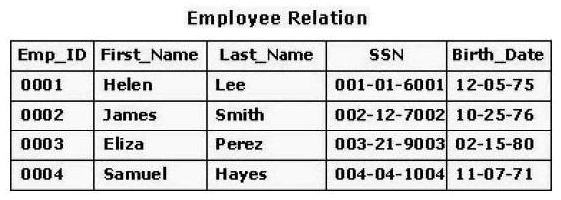
A) 6
B) 20
C) 4
D) 25
F) A) and B)
Correct Answer

verified
Correct Answer
verified
Multiple Choice
Consider the entity-relationship (ER) diagram shown in the exhibit. Which type of relationship between the two entities is shown? 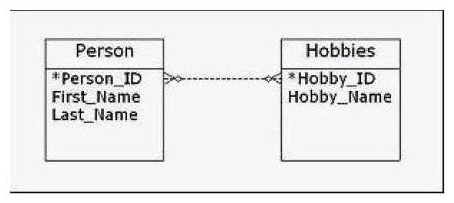
A) A recursive relationship
B) A many-to-many relationship
C) A one-to-one relationship
D) A one-to-many relationship
F) A) and D)
Correct Answer

verified
Correct Answer
verified
Multiple Choice
Consider the relational database shown in the exhibit. What is the foreign key in this database? 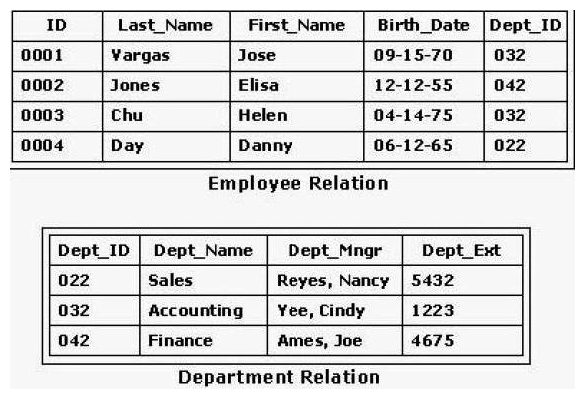
A) Employee. Dept_ID
B) Dept_Mngr
C) Dept_Name
D) Department. Dept_ID
F) A) and C)
Correct Answer

verified
Correct Answer
verified
Multiple Choice
Consider the Recreation relation in the exhibit. A data operation that changes one of the tuples for Student_ID 1003 must be performed. It is necessary to change one of the activities from swimming to tennis. The Student_ID and Activity attributes make up the primary key for the Recreation relation. All related information must be altered, as well. Which SQL statement or statements would best accomplish this? 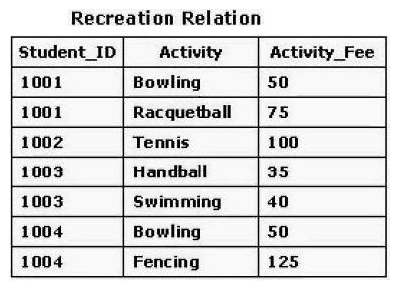
A) UPDATE Recreation SET Activity, Activity_Fee ('Tennis',100) WHERE Student_ID = 1003;
B) UPDATE TABLE Recreation ALTER COLUMN ACTIVITY SET ACTIVITY = 'Tennis', Activity_Fee = 100 WHERE Student__ID = 1003 AND Activity = wimming?AND Activity = ?wimming?
C) UPDATE Recreation SET Activity = 'Tennis', Activity_Fee = 100 WHERE Student_ID = 1003 AND Activity = 'Swimming';
D) DELETE Activity FROM Recreation WHERE Student_ID = 1003; INSERT INTO Recreation VALUES (1003, 'Tennis', 100) ;
F) None of the above
Correct Answer

verified
Correct Answer
verified
Multiple Choice
What is the highest normal form of the relation(s) shown in the exhibit? 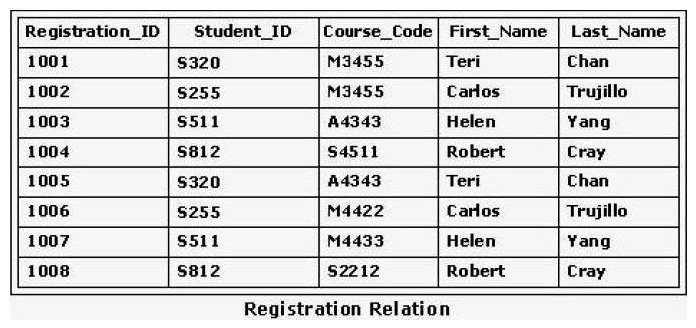
A) Second normal form
B) First normal form
C) Boyce-Codd normal form
D) Third normal form
E) STUDENT( Student_Number: integer NOT NULL Name: variable length character string length 20 NOT NULL) Primary Key Student_Number CLASS( Class_Num: integer NOT NULL Class_Name: integer NOT NULL) Primary Key Class_Num
F) STUDENT( Student_Number: integer NOT NULL Name: variable length character string length 20 NOT NULL) Class_Num Foreign Key Class_Num References STUDENT
G) Primary Key StudenMMumber STU_CLASS( Student_Number: integer NOT NULL Class_Num: integer NOT NULL) Primary Key Student_Number CLASS( Class_Num: integer NOT NULL Class_Name: integer NOT NULL) Primary Key Class_Num
I) B) and D)
Correct Answer

verified
Correct Answer
verified
Multiple Choice
The exhibit shows a relation for a company projects. Which candidate key(s) would best serve as the primary key for this relation? 
A) S_Date and E_Date
B) ProjJD
C) ltem_Num and E_Date
D) Proj_ID and Item_Num
F) All of the above
Correct Answer

verified
Correct Answer
verified
Multiple Choice
Your enterprise is creating a relation (shown in the exhibit) that tracks parts and suppliers. Which situation would occur if new supplier information were entered in the relation before any information about specific parts? 
A) An update anomaly and an insertion anomaly would occur.
B) An insertion anomaly would occur.
C) A deletion anomaly would occur.
D) A deletion anomaly and an update anomaly would occur.
F) A) and D)
Correct Answer

verified
Correct Answer
verified
Multiple Choice
Which subset of Structured Query Language (SQL) is used to limit access to a database or its data?
A) Data Markup Language
B) Data Control Language
C) Data Formatting Language
D) Data Manipulation Language
F) B) and D)
Correct Answer

verified
Correct Answer
verified
Multiple Choice
Consider the table for an employee database shown in the exhibit. What is the degree of the table? 
A) 25
B) 5
C) 4
D) 20
F) B) and C)
Correct Answer

verified
Correct Answer
verified
Multiple Choice
Consider the following SQL statement and the Orders relation shown in the exhibit: What is the output of this SQL statement? SELECT * FROM Orders WHERE NOT (Amount < 1000 AND Sales_Rep_No = 210) ; 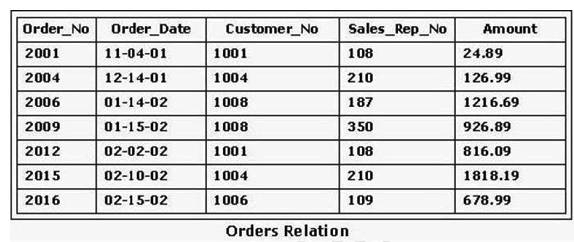

A) Option A
B) Option B
C) Option C
D) Option D
F) A) and C)
Correct Answer

verified
Correct Answer
verified
Showing 21 - 40 of 75
Related Exams